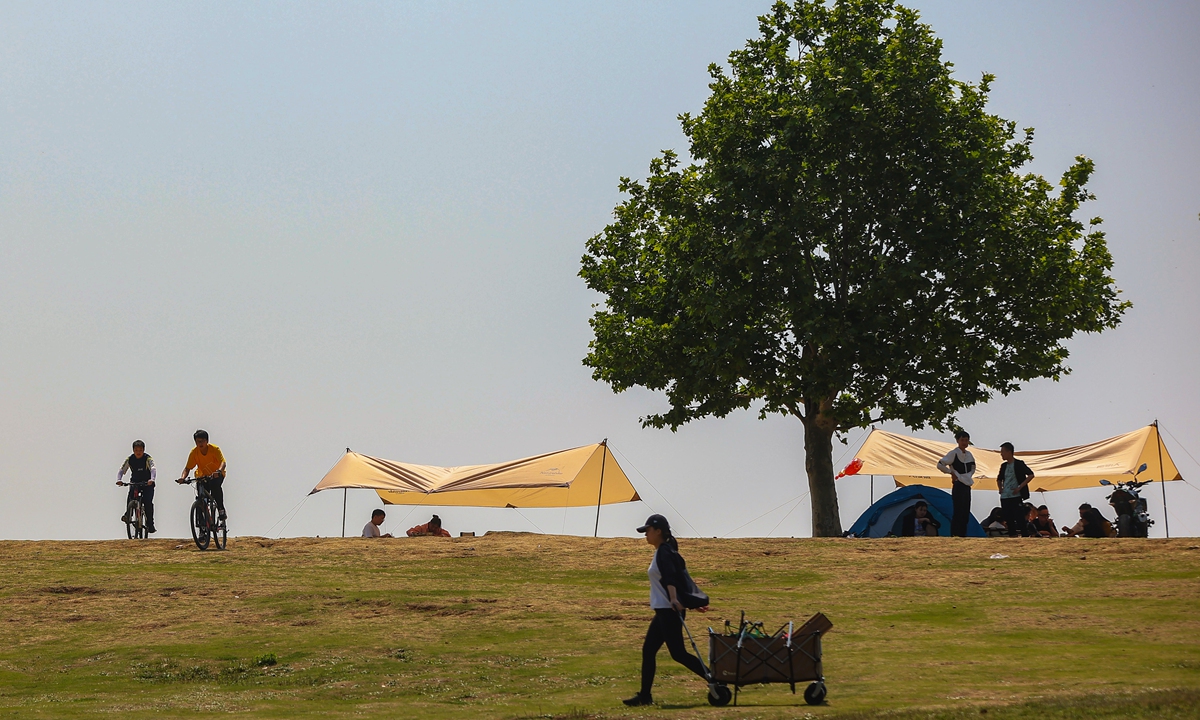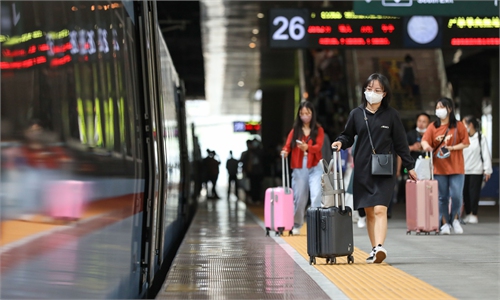Epidemic resurgences bring changes to Chinese sightseers’ consumption habits
Epidemic resurgences bring changes to sightseers’ consumption habits

Residents camping at a park in Nanjing, East China's Jiangsu Province on May 3, 2022. Photo:cnsphoto
China's domestic tourism market has seen a new trend in customer behavior, with a change from trans-provincial travel to short community-based trips, as epidemic prevention and control entered a new phase during the five-day May Day holiday.
While public spending on tourism, especially long-distance travel, reached a historic low, expenditures on short-distance trips and picnics saw a significant jump as cities and provinces encouraged local residents to stay in for epidemic control during the holiday.
The epidemic has resurged in many provinces, with more frequent occurrences since March. Affected by the epidemic situation and local virus control policies, the public's travel radius during the holidays was significantly reduced compared with previous times, a trend that industry analysts said was within expectations, and the booming market for short-distance trips offered new opportunities for businesses.
Data released by the Ministry of Culture and Tourism on Wednesday afternoon showed that during the five-day May Day holiday, 160 million domestic trips were made across the country, a year-on-year decrease of 30.2 percent.
Domestic tourism revenue reached 64.68 billion yuan ($ 9.78 billion), a year-on-year decrease of 42.9 percent.
Passenger flows across the country have run at a relatively lower level as cities and provinces encourage stay-in in an effort to stifle the spread of the virus.
From April 30 to May 4, the national railways are expected to carry 15.955 million passengers, a year-on-year decrease of around 30 percent, the latest data from China Railway showed. The large drop was within expectations and matched the prediction issued by the Ministry of Transport ahead of the holiday.
Zhou Min, deputy director of the emergency office of the ministry, told a press conference on April 28 that the national passenger volume during the holiday is estimated at 100 million, with an average of 20 million passengers per day, a decrease of about 62 percent compared with the same period in 2021.
The Civil Aviation Administration of China also predicted that the number of air passengers during the May Day holiday would drop by 77 percent year-on-year, according to media reports.
Beijing, a major tourism destination, restricted traffic flows for parks and public entertainment spots by allowing only 50 percent of the usual level of visitors, while several scenic spots in other provinces all put restrictions on traffic. All of these factors have contributed to the sluggish market demand.
Despite the foreseeable impacts, some businesses significantly rebounded during the holiday, with products such as short-distance or community-based trips gaining more popularity among city residents, the Global Times has learned.
Data from travel platform Qunar.com showed that, as of Wednesday morning, among the passengers who booked train tickets on the platform, those who traveled within their provinces accounted for 70 percent, and the number of bus ticket bookings for travel within provinces increased by more than 50 percent compared with the week before the holiday.
The bookings of picnic-related products tripled year-on-year during the holiday while ticket sales for local parks where people could go for picnics jumped by 40 percent.
Corresponding hotel bookings also increased by 1.5 times year-on-year, according to Qunar.com.
The number of campers in regions in southern China, where the epidemic situation is relatively under control, increased rapidly, with the highest increase hitting three times compared with the previous week before the holiday.
Data that Mafengwo, a user-generated travel content website in China, sent to the Global Times on Wednesday showed that in the past week, the average search popularity of "camping" increased by more than 130 percent.
Moreover, in the past week, the average search popularity of "self-driving" in Mafengwo increased by nearly 70 percent.
A report sent by online travel agency Lvmama to the Global Times showed that local travel became the mainstream choice during the holiday, especially in Southwest China's Sichuan and Chongqing, as well as the Pearl River Delta region where sporadic cases are reported.
From the booking rate of the platform, those who booked tour services and products within the cities where they live accounted for a significant 65 percent, while those who traveled within provinces made up 30 percent, according to Lvmama.
Zou Qingling, CEO of Lvmama, said that the market environment, consumers, their needs and marketing models of the tourism industry are undergoing rapid and profound changes now.
While there are challenges for the industry, the change will also create new opportunities for tourism, insiders said.

